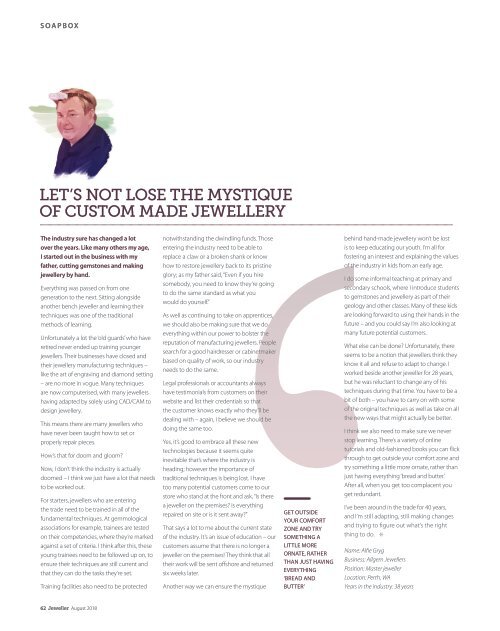You also want an ePaper? Increase the reach of your titles
YUMPU automatically turns print PDFs into web optimized ePapers that Google loves.
SOAPBOX<br />
LET’S NOT LOSE THE MYSTIQUE<br />
OF CUSTOM MADE JEWELLERY<br />
The industry sure has changed a lot<br />
over the years. Like many others my age,<br />
I started out in the business with my<br />
father, cutting gemstones and making<br />
jewellery by hand.<br />
Everything was passed on from one<br />
generation to the next. Sitting alongside<br />
another bench jeweller and learning their<br />
techniques was one of the traditional<br />
methods of learning.<br />
Unfortunately a lot the ‘old guards’ who have<br />
retired never ended up training younger<br />
jewellers. Their businesses have closed and<br />
their jewellery manufacturing techniques –<br />
like the art of engraving and diamond setting<br />
– are no more in vogue. Many techniques<br />
are now computerised, with many jewellers<br />
having adapted by solely using CAD/CAM to<br />
design jewellery.<br />
This means there are many jewellers who<br />
have never been taught how to set or<br />
properly repair pieces.<br />
How’s that for doom and gloom?<br />
Now, I don’t think the industry is actually<br />
doomed – I think we just have a lot that needs<br />
to be worked out.<br />
For starters, jewellers who are entering<br />
the trade need to be trained in all of the<br />
fundamental techniques. At gemmological<br />
associations for example, trainees are tested<br />
on their competencies, where they’re marked<br />
against a set of criteria. I think after this, these<br />
young trainees need to be followed up on, to<br />
ensure their techniques are still current and<br />
that they can do the tasks they’re set.<br />
Training facilities also need to be protected<br />
notwithstanding the dwindling funds. Those<br />
entering the industry need to be able to<br />
replace a claw or a broken shank or know<br />
how to restore jewellery back to its pristine<br />
glory; as my father said, “Even if you hire<br />
somebody, you need to know they’re going<br />
to do the same standard as what you<br />
would do yourself.”<br />
As well as continuing to take on apprentices,<br />
we should also be making sure that we do<br />
everything within our power to bolster the<br />
reputation of manufacturing jewellers. People<br />
search for a good hairdresser or cabinetmaker<br />
based on quality of work, so our industry<br />
needs to do the same.<br />
Legal professionals or accountants always<br />
have testimonials from customers on their<br />
website and list their credentials so that<br />
the customer knows exactly who they’ll be<br />
dealing with – again, I believe we should be<br />
doing the same too.<br />
Yes, it’s good to embrace all these new<br />
technologies because it seems quite<br />
inevitable that’s where the industry is<br />
heading; however the importance of<br />
traditional techniques is being lost. I have<br />
too many potential customers come to our<br />
store who stand at the front and ask, “Is there<br />
a jeweller on the premises? Is everything<br />
repaired on site or is it sent away?”<br />
That says a lot to me about the current state<br />
of the industry. It’s an issue of education – our<br />
customers assume that there is no longer a<br />
jeweller on the premises! They think that all<br />
their work will be sent offshore and returned<br />
six weeks later.<br />
Another way we can ensure the mystique<br />
GET OUTSIDE<br />
YOUR COMFORT<br />
ZONE AND TRY<br />
SOMETHING A<br />
LITTLE MORE<br />
ORNATE, RATHER<br />
THAN JUST HAVING<br />
EVERYTHING<br />
‘BREAD AND<br />
BUTTER’<br />
behind hand-made jewellery won’t be lost<br />
is to keep educating our youth. I’m all for<br />
fostering an interest and explaining the values<br />
of the industry in kids from an early age.<br />
I do some informal teaching at primary and<br />
secondary schools, where I introduce students<br />
to gemstones and jewellery as part of their<br />
geology and other classes. Many of these kids<br />
are looking forward to using their hands in the<br />
future – and you could say I’m also looking at<br />
many future potential customers.<br />
What else can be done? Unfortunately, there<br />
seems to be a notion that jewellers think they<br />
know it all and refuse to adapt to change. I<br />
worked beside another jeweller for 28 years,<br />
but he was reluctant to change any of his<br />
techniques during that time. You have to be a<br />
bit of both – you have to carry on with some<br />
of the original techniques as well as take on all<br />
the new ways that might actually be better.<br />
I think we also need to make sure we never<br />
stop learning. There’s a variety of online<br />
tutorials and old-fashioned books you can flick<br />
through to get outside your comfort zone and<br />
try something a little more ornate, rather than<br />
just having everything ‘bread and butter.’<br />
After all, when you get too complacent you<br />
get redundant.<br />
I’ve been around in the trade for 40 years,<br />
and I’m still adapting, still making changes<br />
and trying to figure out what’s the right<br />
thing to do. i<br />
Name: Alfie Gryg<br />
Business: Allgem <strong>Jeweller</strong>s<br />
Position: Master jeweller<br />
Location: Perth, WA<br />
Years in the industry: 38 years<br />
62 <strong>Jeweller</strong> <strong>August</strong> <strong>2018</strong>


















